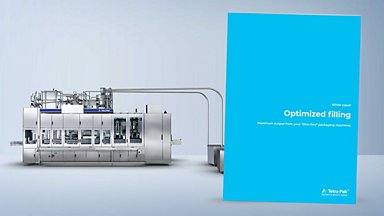We are constantly looking for ways to improve the filling performance of our filling machines. Here we look at three new updates to the Tetra Rex machine and how they take filling performance to the next level, from reduced parts wear and less splashing to improved motor performance.
1. Achieve precise filling with the new UPV algorithm
One of the critical steps in the filling process is the opening and closing of the universal product valves (UPVs). Precision opening and closing ensures that you get the correct volume into the packages without after-dripping and damage to filling components, such as wear on the filling membrane.
The introduction of new analogue sensors on our UPVs lets us see and control their position and speed while opening and closing.
Thanks to a new self-learning algorithm, the Tetra Rex machine monitors the UPV positions in relation to the filling pump’s position. It can determine precisely when the valves should be opened and closed, and has the ability to control this adjustment by itself.
A time-consuming part of filling optimisation at our customers is often the fine-tuning of the air restrictors on the UPV valves in order to achieve the overlap and timing that they need. With the new sensors and algorithm, this procedure will be much more effective and time saving.
Not only will this be a time-saving improvement when running the machine for the first time, but the new feature will also optimise continuously. This reduces the wear on the pneumatic UPVs as we continue to optimise based on the valves’ condition.
2. Optimised movements thanks to station chain improvements
When improving filling, it’s important to not forget the station chain. Without improvements in the chain, the improved filling itself will have no effect.
The new station chain movement now has a ‘higher resolution’, which means that the chain is more fine-tuned in all its positions during the machine cycle. For the station chain itself, this means a more optimised movement where the wear on the chain will be reduced, while motor performance is increased.
The improved station chain movement on the Tetra Rex machine means better control over the timing of when the chain starts and stops during the filling process.
When the chain is stopped, it should be aligned with the lifter to prevent packages tilting when lifted, which causes uneven distribution. With the new optimisation, stops are softer with the lifting of the packages synchronised.
During the restart after the packages are filled, it’s important to start the chain movement before the lifter reaches its bottom position to limit splashing.
3. Reduced splashing and after-dripping with a more stable carton lifter
The carton lifter is responsible for one of the most critical movements during filling. Timing is everything: starting and stopping must occur at precisely the right time to ensure there is as much time as possible to fill the packages; and determining exactly when the carton grippers should open and close gives full control over the packages to eliminate the risk of tilting during filling.
With a non-optimised lifter, splashing and after-dripping will occur.
The new improvements to the carton lifter mostly focus on the motion of the lifter. The motor parameters have been tuned and the range of movements increased. The new carton lifter motion will lead to better filling, with a more stable lifter motion. The new changes make it possible to reduce splashing and after-dripping even more than before.








